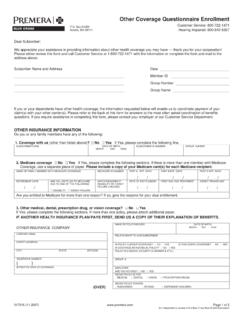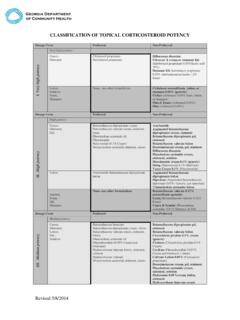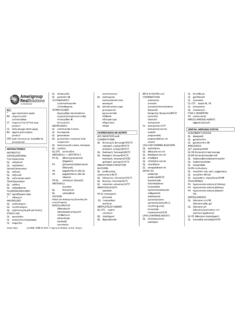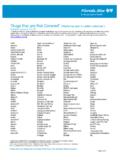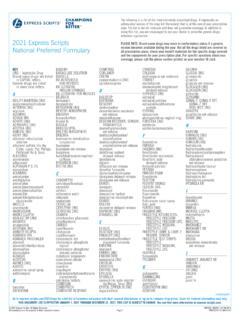Transcription of 5.01.575 Dupixent® (dupilumab) - Premera Blue Cross
1 PHARMACY / MEDICAL POLICY Dupixent (dupilumab). Effective Date: Dec. 1, 2021 RELATED MEDICAL POLICIES: Last Revised: Nov. 18, 2021 Xolair (omalizumab). Replaces: N/A IL-5 Inhibitors Select a hyperlink below to be directed to that section. POLICY CRITERIA | DOCUMENTATION REQUIREMENTS | CODING. RELATED INFORMATION | EVIDENCE REVIEW | REFERENCES | HISTORY. Clicking this icon returns you to the hyperlinks menu above. Introduction Atopic dermatitis (AD) is a chronic skin condition. (Chronic means the condition lasts a long time or returns again and again.) Symptoms of AD include weeping, oozing plaques, itchy skin, raised red rashes or rashes that appear to have small blisters, dry and flaky skin, and increased allergic reaction (IgE reactivity). A person with AD may also have a personal or family history of hay fever or other skin conditions. The itchy skin can be triggered by a number of situations.
2 These include heat and perspiration, wool, emotional stress, specific foods, and house dust mites. Scratching and rubbing irritate the skin and increase inflammation, which leads to more itching. Medications called corticosteroids are often successful in treating AD. Asthma is a long-term lung condition affecting the airways of the lung. Asthma causes the airways to become inflamed. Inhaling certain substances such as tobacco smoke, pet dander, and dust mites can set off a chain reaction. The immune system produces substances called cytokines that contribute to the inflammation in asthma. Dupixent is a drug that helps prevent the inflammation response in asthma by blocking cytokines. It's typically prescribed to treat moderate-to-severe asthma when symptoms aren't controlled by inhaled corticosteroids or use of oral corticosteroids. Chronic rhinosinusitis with nasal polyposis (CRSwNP) is a condition where the sinuses and nasal passages become inflamed and contain non-cancerous growths (polyps).
3 Symptoms of CRSwNP include mucus drainage from the nose or down the back of the throat, facial pain, pressure and/or a sensation of fullness, nasal blockage, and a reduced sense of smell. Dupixent is a drug that is prescribed as an add-on treatment for CRSwNP that isn't controlled by using an intranasal corticosteroid. This policy describes when Dupixent may be considered medically necessary to treat AD, asthma or CRSwNP. Note: The Introduction section is for your general knowledge and is not to be taken as policy coverage criteria. The rest of the policy uses specific words and concepts familiar to medical professionals. It is intended for providers. A provider can be a person, such as a doctor, nurse, psychologist, or dentist. A provider also can be a place where medical care is given, like a hospital, clinic, or lab. This policy informs them about when a service may be covered.
4 Policy Coverage Criteria Indication Medical Necessity Atopic dermatitis Dupixent (dupilumab) may be considered medically necessary for the treatment of patients 6 years of age and older with moderate to severe atopic dermatitis when: The patient has a diagnosis of atopic dermatitis involving 10%. of his or her body surface area (BSA). o Exception: this may be granted for extensive recalcitrant facial involvement, pustular involvement of the hands or feet, and genital involvement which interferes with normal sexual function. AND. Patient has had an inadequate response or intolerance to one topical calcineurin inhibitor medication, such as pimecrolimus or tacrolimus. AND. Patient has had an inadequate response or intolerance to two topical corticosteroid medications of high potency, such as: betamethasone dipropionate, mometasone furoate, fluocinonide, or clobetasol propionate .
5 O Exception: this may be granted for face or genital involvement AND. For adults the maintenance dose prescribed is 300 mg given every other week OR. For adolescents the maintenance dose prescribed is: o 300 mg every four weeks if less than 30 kg o 200 mg every other week if 30 kg and less than 60 kg Page | 2 of 24 . Indication Medical Necessity o 300 mg every other week if 60 kg or more Moderate-to-severe Dupixent (dupilumab) may be considered medically asthma necessary for the treatment of patients 12 years of age and older with moderate-to-severe asthma when: The patient has a diagnosis of moderate-to-severe asthma AND. Patient is 6 years of age or older AND. Patient is using maximum doses of an inhaled corticosteroid AND. Patient is using an inhaled long-acting beta-agonist (LABA). AND. Patient has oral corticosteroid dependent asthma defined as: o Two or more asthma exacerbations in the previous 12.
6 Months requiring use of oral corticosteroids OR. o Has a dependence on oral corticosteroids of at least 5 mg per day of prednisone or equivalent OR. Patient has asthma with an eosinophilic phenotype and had AT. LEAST ONE of the following 3 criteria in the previous 12 month: o Blood esosinophil** count greater than 150 cells/mcL. OR. o Sputum eosinophil** count greater than or equal to 3%. OR. o Patient has oral corticosteroid dependent asthma and is not able to discontinue use of oral corticosteroids for blood eosinophil or sputum eosinophil tests AND. For adults and adolescents 12 years and older the maximum maintenance dose prescribed is 300 mg given every other week OR. For pediatric patients 6 to 11 years of age the maximum maintenance dose prescribed is: o 300 mg every four weeks for body weight 15 to < 30 kg o 200 mg every other week for body weight 30 kg AND.
7 Page | 3 of 24 . Indication Medical Necessity Dupixent (dupilumab) is not used in combination with Cinqair (reslizumab), Fasenra (benralizumab), Nucala . (mepolizumab), or Xolair (omalizumab) when the medications are being used for the treatment of asthma Note: **Eosinophil count is count is a type of blood test that measures the quantity of a type of white blood cell called eosinophils. If the number in the blood or sputum is high (greater than 150 cells/mcL or 3%, respectively), this suggests that the patient is unresponsive to their regular maintenance (inhaled or oral) corticosteroid treatment, in which case dupilumab can be considered medically necessary. Chronic rhinosinusitis with Dupixent (dupilumab) may be considered medically nasal polyposis necessary as an add-on maintenance treatment in adult patients with inadequately controlled chronic rhinosinusitis with nasal polyposis (CRSwNP) when: Patient is 18 years of age or older AND.
8 Diagnosed with inadequately controlled bilateral CRSwNP. AND. At least two of the following are present: o Facial pressure or pain o Moderate to severe nasal congestion or obstruction o Significant loss of smell AND. Adequate trial and failure of one intranasal corticosteroid as monotherapy AND. One of the following: o Prior use of systemic corticosteroids to treat nasal polyps in the last 2 years OR. o Previous surgical removal of the bilateral nasal polyps AND. Prescribed in combination with an intranasal corticosteroid AND. Prescribed by or in consultation with an allergist/immunologist or otolaryngologist Page | 4 of 24 . Indication Medical Necessity AND. Maintenance dose presribed is 300 mg given every other week Drug Investigational Dupixent (dupilumab) Use of Dupixent (dupilumab) in patients < 6 years of age is considered investigational. All other uses of Dupixent (dupilumab) for conditions not outlined in the Medical Necessity section above are considered investigational.
9 Length of Approval Approval Criteria Initial authorization Dupixent (dupilumab) may be approved up to 6 months. Re-authorization criteria Future re-authorization of Dupixent (dupilumab) may be approved up to 12 months as long as the drug-specific coverage criteria are met and chart notes demonstrate that the patient continues to show a positive clinical response to therapy as documented by the following for each diagnosis: Atopic dermatitis Decrease in the BSA involvement AND. Amelioration of the associated symptoms (ie, pruritus, inflammation, redness, etc.). Moderate-to-severe asthma Decrease in requirements for oral steroids, exacerbation frequency, ER and urgent care visits, hospitalizations OR. Decrease in frequency and severity of asthma symptoms OR. Increase in quality of life measures and ability to perform activities of daily living Page | 5 of 24.
10 Length of Approval Approval Criteria Chronic rhinosinusitis with nasal polyposis Decrease from baseline of nasal polyp size unless previous surgical removal of nasal polyps AND. Decrease from baseline of nasal congestion/obstruction AND. Improvement from baseline of sense of smell Documentation Requirements The patient's medical records submitted for review for all conditions should document that medical necessity criteria are met. The record should include the following: Office visit notes that contain the diagnosis, relevant history, physical evaluation, lab results and medication history Coding Code Description HCPCS. J3590 Unclassified biologics (use to report Dupixent ). Note: CPT codes, descriptions and materials are copyrighted by the American Medical Association (AMA). HCPCS. codes, descriptions and materials are copyrighted by Centers for Medicare Services (CMS).
